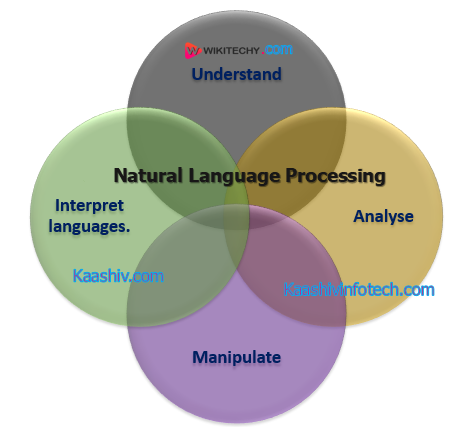What is NLP ?
- NLP stands for Natural Language Processing.
- NLP is a part of Computer Science, Human language, and Artificial Intelligence.
- NLP is used by means of machines to:
- Understand
- Analyse
- Manipulate
- Interpret human's languages.

NLP
- It helps developers to organize knowledge for performing tasks:
- Translation, Automatic summarization.
- Named Entity Recognition (NER), speech recognition.
- Relationship extraction, and Topic segmentation.
History of NLP
1940-1960
- Focused on Machine Translation (MT) and Natural Languages Processing started in 1940s.
1948
- The first recognisable NLP application was introduced in Birkbeck College, London.
1950s
- There was a conflicting view between linguistics and computer science. Chomsky developed his first book syntactic structures also claimed that language is generative.
1957
- Chomsky introduced the idea of Generative Grammar rule based descriptions of syntactic structures.
1960-1980 - Combined Artificial Intelligence
- From 1960 to 1980, the key developments were:
Augmented Transition Networks (ATN)
- ATN is a finite state machine that is capable of recognizing regular languages.
Read Also
Case Grammar
- Case Grammar was developed by Linguist Charles J. Fillmore in 1968.
- In Case Grammar, case roles are defined to link certain kinds of verbs and objects.
From 1960 to 1980, key systems were:
Shrdlu
- SHRDLU is a program written by Terry Winograd in 1968-70. It helps users to communicate with the computer and moving objects.
Lunar
- LUNAR is the classic example of a Natural Language database interface system that is used ATNs and Woods' Procedural Semantics.
1980 - Present
- Natural language processing systems based on complex sets of hand-written rules. After 1980, NLP introduced machine learning algorithms for language processing.
- From the beginning of the year 1990s, NLP started growing faster and achieved good process accuracy, especially in English Grammar. The availability of computers with fast CPUs and more memory. The major factor behind the advancement of natural language processing was the Internet.
- The modern NLP consists of various applications, like speech recognition, machine translation, and machine text reading.
